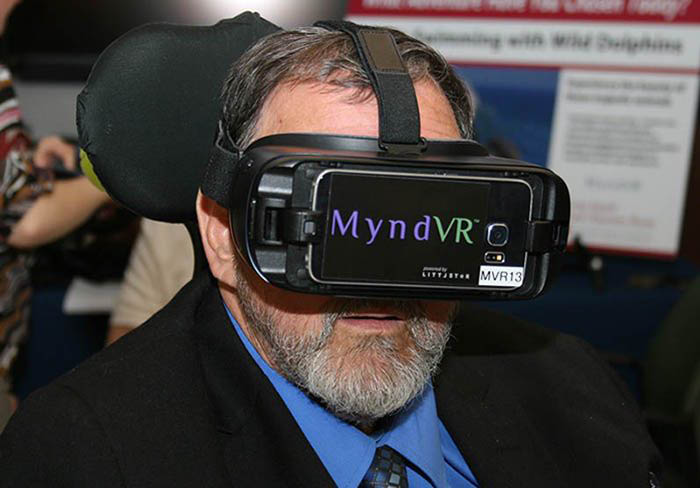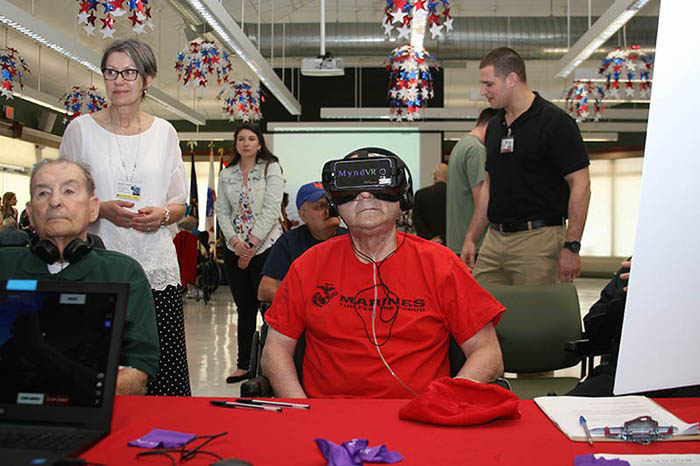
On Wednesday morning at the Long Island State Veterans Home (LISVH) in Stony Brook, resident Al Anderson was feeling agitated.
His wife was in the hospital, and not being there for her stirred up waves of emotion in the Vietnam veteran. Like many others who have served our country, Anderson now lives with anxiety, depression and post-traumatic stress disorder (PTSD).
That day’s outcome would be different, however, thanks to a groundbreaking new initiative at the home, a major teaching affiliate of Stony Brook Medicine. Anderson would be among the first at the LISVH to try out their recently-acquired virtual reality headsets.
He slipped on high-tech goggles and headphones, and in seconds he was stepping onto a racetrack, fully immersed in a NASCAR race.
“I put these goggles on and I got to have the whole experience, from walking into the gate to helping the crew work on the car to riding in the car,” said Anderson, 72, who served in the Army’s Special Forces. “I’m a big NASCAR fan and raced stock cars when I was younger, so this [setting]was something I thought I would relate to and enjoy the most.”
At the end of his 20-minute session, the effects were clear: Anderson was happy again, and had a calmer perspective on his wife’s hospital stay. Now, he’s thrilled to begin using the technology on a regular basis.
Located on the campus of Stony Brook University, the home is a key part of the educational experience for students pursuing careers in geriatric or long-term care, along with nurses, therapists, paramedicals and social workers. LISVH is one of only a few nursing homes in the country that are fully integrated into the health and educational mission of a major teaching and research university. This affiliation provides Long Island’s veterans access to the New York metropolitan region’s best health care professionals and most advanced medical and recreational technology.
Use of virtual reality headsets is the latest technology-driven therapeutic initiative put into action by the facility as a means to advance veterans’ well-being and quality of life.
Embracing the latest advancements in technology has long been a part of the LISVH’s mission, said deputy executive director Jonathan Spier. Residents can learn to communicate with faraway family members via Skype, and many of the home’s 350 veterans have their own MP3 players or use them during therapy.

World War II veteran Ed Kiernan, left, and Vietnam veteran Anthony Zaccarello
Thanks to financial support from the Bowlers to Veterans Link charitable foundation, the LISVH is the first state veterans home in the country to offer virtual reality experiences to residents.
LISVH has partnered with MyndVR, a Texas-based startup company that creates new virtual reality scenarios, from calming nature walks to swimming with dolphins, playing sports and even military exercises. They have provided the home with an initial batch of 50 scenes and will continue to send additional ones
The veterans home is planning to use the new systems both in group settings and individually, said Michelle Cheslak, director of therapeutic recreation at LISVH and a certified therapeutic recreational specialist. In groups, the veterans can all participate in the same scene while the therapist keeps track of each user’s screen via a handheld tablet.
Group therapy will provide the veterans with a shared experience that the therapist can direct according to their specific goals, Cheslak said.
“We can stimulate conversation by asking questions about what they’re seeing or feeling, or by directing them to look at certain items in the scene while on the same adventure. For example, one person might see a deer during a hiking scenario. I can see that on the tablet, and tell the group to look to the right to search for it,” Cheslak explained.
After the session ends, the therapist might ask the group to talk about their experiences together, perhaps trading old stories or memories the scene stirs up, Cheslak said. These conversations work to build sociability, comfort and familiarity among the residents.
The therapeutic use of virtual technology can have a variety of benefits depending on who is using the system and what scenarios are chosen. A familiar hobby or location might be used for a resident with dementia, while a resident with PTSD might choose to walk on the beach.
Choosing the appropriate adventure is critical to ensure that residents have safe, positive experiences with VR. Spier said that LISVH works closely with each veteran, his or her family and care team in all of its decision-making.
“It’s about knowing which residents are going to be a good fit for the program, as well as their likes, dislikes and the trigger points for their anxiety,” Cheslak said.
By Melissa Arnold
Virtual Reality Tool Serves as Therapy at Long Island State Veterans Home was originally published on the Stony Brook University website.